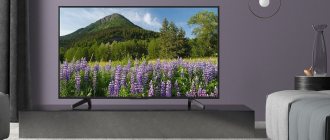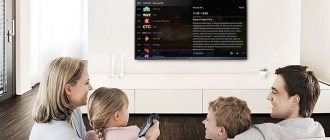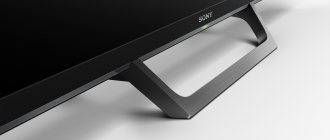Smart TV or Android TV: which is better? In the case of Smart TV, the user is offered a completely finished TV. Smart TV OS is specially designed for playing sound and video files, working with search queries by entering them with a remote control or voice. A set-top box is a separate device that is connected to a regular digital TV. Let's look at both of these solutions.
Pros and cons of Smart TV
Let's start with a smart TV - this is how the concept of Smart TV is translated. Essentially, this is a TV equipped with an operating system, thanks to which you can significantly expand its functionality. Each manufacturer - LG, Samsung, Philips, Sony, Xiaomi, etc. - has its own operating system. LG has WebOS, Samsung has Tizen. Despite the fact that they are all designed to solve the same problems, there are significant differences in the implementation of these smartest functions. Due to which one system is better suited for one thing, another for another. But in order to accurately understand which one is more comfortable for you to use, you need to try each of them in practice, which for obvious reasons is unrealistic.
The main disadvantages of TVs with built-in Smart TV is the lack on one or another platform of a sufficient number of applications necessary for full operation - file managers, media players, programs for broadcasting the smartphone screen, games, video messengers, etc. And also limited possibilities for using connected devices - mouse, keyboard, microphone and others.
In addition, as a rule, all manufacturers do not support their devices for more than 1-2 years. Updates stop coming, as a result of which the shell becomes outdated, new versions of applications stop working, and you cannot fully use them.
As a result, it often happens that due to an incorrect choice when purchasing a Smart TV, you have to purchase a TV set-top box separately and not use the built-in functionality of the TV. That is, in fact, it would be more profitable to initially buy a TV without Smart TV and a set-top box for it.
A universal solution would be to purchase a TV not with a specific Smart TV from the manufacturer, but specifically running the Android operating system. That is, out of the box, such a TV is a large tablet with an interface adapted for control from a remote control. But at the same time it has all the capabilities inherent in a regular smartphone. That is, you can connect to it via Bluetooth or via USB ports any third-party devices that support these interfaces - speakers, keyboards, headphones, air mouse, voice-controlled remote control, and so on.
The range of various applications is also not limited - they can be installed both from the official Google Play Store and from third-party stores (such as >>Aptoide) or even from files with the APK extension downloaded from forums.
Android system updates will come regularly from the official developer. And only you can decide whether to install them or not.
What is your opinion: is WiFi harmful?
Yes
22.94%
No
77.06%
Voted: 33178
But here the question arises of the technical characteristics of the hardware of the TV itself. To reduce the cost of devices, many manufacturers install not very powerful processors, a small amount of RAM and built-in memory, and do not equip them with a 5 GHz WiFi module or, conversely, a network connector for an Internet cable. As a result, we have a TV with a full package of Android TV functions, but which are impossible to use comfortably, as it does not support high-definition video, the Internet slows down on it, there is no way to install many applications and download files, or the entire interface lags due to several simultaneously running programs.
The same TV models that do not have these shortcomings cost a lot of money, and you don’t even look in their direction when looking for offers that are suitable for the price.
Reasons for popularity:
- improved functionality;
- user-friendly interface;
- simple controls.
As for the last point, it happens using the remote control. In other words, a “smart” TV gives you the right to view various files, programs recorded or online, freely use Internet resources, communicate on social networks and even make video and voice calls. Also, the features of Smart TV include watching movies in 3D. This is available for devices that support the feature.
It is important to understand that technology concerns not only televisions, but also devices such as video players, game consoles and receivers.
Possibilities:
- Control TV functions via one remote control.
- Convenient navigation with arrows, which is much more comfortable and easier than operating from the keyboard of a personal computer.
- A wide selection of applications for watching movies, cartoons and TV programs.
- The ability to implement video calls on Skype and communication on various social networks. Some device models are equipped with a built-in camera, but if not, you can purchase it separately.
- There is a unique opportunity to control technology using facial expressions and gestures. This smart TV can also recognize faces.
- The application store contains games and useful programs (for example, exchange rates, weather forecasts, government services), which can be downloaded to your TV absolutely free.
- The convenient menu displayed on the screen is quite simple and understandable. It allows you to quickly find and launch applications of interest.
A not very pleasant feature of Smart TV is problems with video rewinding. Sometimes it switches to the next video by mistake or starts over again. Then you have to rewind the video file again. But such a trifle should not negate all the advantages of the technology.
The emergence of technology is due to the increased need of modern users for access to the Internet. A TV with ordinary functions can no longer satisfy desires. Smart TV provides the opportunity to watch terrestrial and cable TV channels, online broadcasts of television programs and sports competitions, films, clips, and series.
Advantages and disadvantages of Smart TV set-top boxes on Android
Unlike TVs, all set-top boxes are based on the Android TV system. Therefore, they are immediately universal and do not have the disadvantages inherent in Smart TVs with operating systems from LG, Sony, Samsung, etc. However, they have all the same advantages and disadvantages as TVs with built-in Android TV, which I mentioned above.
In terms of price, buying a good TV on Android may be a little more expensive than a simple TV with a set-top box. But this difference is becoming smaller from year to year. However, the main advantage of a set-top box over a TV is the ability to connect it to any new or old TV. For example, if you want a larger diagonal, you can change your TV quite inexpensively and connect to it the same set-top box that you used before. And you don’t even have to configure anything again.
The only downside that can be noted is the need to use two control panels at the same time. The TV will listen to one, and the Smart TV set-top box will listen to another. On a full-fledged smart TV, this shortcoming is absent, since all functions are concentrated on one remote control.
However, changing it to another model will be more difficult financially. In addition, the TV will have to be configured again - connect to the Internet, log in to your Google account, download and install the entire package of necessary applications.
Programming the smart remote control
By the way, several buttons on the remote control of the set-top box are programmed for any TV. As it turned out, this is done simply: take the remote control from the smart set-top box and the remote control from the TV.
- Press and hold the white button on the programmable remote control for a few seconds until the light turns red.
- Press the button that needs to be programmed once, for example vol+, the white button will start flashing.
- We direct the remote control from the TV to each other, as shown in the figure, and press the button on the television remote control that we want to transfer to the programmable remote control, for example, increasing the volume.
- The white button will quickly blink red and light up permanently, which means the button has been programmed and you can begin programming the next button.
- After programming all the buttons, you can wait a few seconds until the white button goes out or press any black button, for example OK, to exit the programming mode.
I programmed the remote control for the Supra TV like this: TV IN - enable the transition mode to HDMI 1,2,3 Vol- and Vol+, respectively, down and up as selected in the menu. SET - OK button and the white button itself - on. and off TV.
For your TV, do whatever is most convenient for you.
I will describe one main nuance about programming the remote control. At first I couldn’t program the buttons, although I did everything as described above.
It turned out that the whole problem was due to dead batteries in the TV remote control.
The TV remote control itself worked, that is, it switched and adjusted the volume, but when programming the remote control, apparently there was not enough power to send a signal to another remote control.
So take note, otherwise I suffered for 2 days until I figured out the reason for not programming the remote control.
What to choose - Smart TV or Android TV set-top box?
What conclusion can be drawn from all that has been said? What to choose - Smart TV, Android TV or smart set-top box?
- For beginners or those who do not currently have money for a good smart TV, I recommend buying a high-quality Android TV set-top box and a more inexpensive TV. This is the best option for all occasions
- You can buy a TV with Smart TV only if you are completely sure that the existing functions in it will be sufficient for a long time of use.
- A full-fledged TV on Android is worth choosing if you have a budget for it and you are definitely not going to change it over the next few years.
Which set-top box or TV is better?
To avoid problems using both the TV and the Android Smart TV set-top box, the device must meet the following parameters:
- The most modern CPU and video core possible
- Built-in memory size of at least 8 GB
- RAM - at least 2 GB
- Availability of WiFi 5 GHz or Ethernet port for cable Internet
- Bluetooth 5.0 support
- The version of Android that is optimal for this processor. There is no need to chase the novelty of the system, the main thing is that the TV can easily handle its operation. For weak hardware, Android 7 is better, while for powerful hardware, 9, 10, etc. are suitable.
I hope these tips will help you decide whether to choose a Smart TV or Android TV. Ask questions in the comments.











